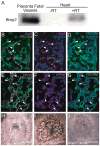Genetic interaction between Bmp2 and Bmp4 reveals shared functions during multiple aspects of mouse organogenesis
- PMID: 19116164
- PMCID: PMC2891503
- DOI: 10.1016/j.mod.2008.11.008
Genetic interaction between Bmp2 and Bmp4 reveals shared functions during multiple aspects of mouse organogenesis
Abstract
Vertebrate Bmp2 and Bmp4 diverged from a common ancestral gene and encode closely related proteins. Mice homozygous for null mutations in either gene show early embryonic lethality, thereby precluding analysis of shared functions. In the current studies, we present phenotypic analysis of compound mutant mice heterozygous for a null allele of Bmp2 in combination with null or hypomorphic alleles of Bmp4. Whereas mice lacking a single copy of Bmp2 or Bmp4 are viable and have subtle developmental defects, compound mutants show embryonic and postnatal lethality due to defects in multiple organ systems including the allantois, placental vasculature, ventral body wall, skeleton, eye and heart. Within the heart, BMP2 and BMP4 function coordinately to direct normal lengthening of the outflow tract, proper positioning of the outflow vessels, and septation of the atria, ventricle and atrioventricular canal. Our results identify numerous BMP4-dependent developmental processes that are also very sensitive to BMP2 dosage, thus revealing novel functions of Bmp2.
Figures





Similar articles
-
Bmp2 and Bmp4 genetically interact to support multiple aspects of mouse development including functional heart development.Genesis. 2009 Jun;47(6):374-84. doi: 10.1002/dvg.20511. Genesis. 2009. PMID: 19391114 Free PMC article.
-
BMP7 functions predominantly as a heterodimer with BMP2 or BMP4 during mammalian embryogenesis.Elife. 2019 Sep 30;8:e48872. doi: 10.7554/eLife.48872. Elife. 2019. PMID: 31566563 Free PMC article.
-
Dynamics and cellular localization of Bmp2, Bmp4, and Noggin transcription in the postnatal mouse skeleton.J Bone Miner Res. 2015 Jan;30(1):64-70. doi: 10.1002/jbmr.2313. J Bone Miner Res. 2015. PMID: 25043193 Free PMC article.
-
Genetic analysis of the roles of BMP2, BMP4, and BMP7 in limb patterning and skeletogenesis.PLoS Genet. 2006 Dec;2(12):e216. doi: 10.1371/journal.pgen.0020216. Epub 2006 Nov 6. PLoS Genet. 2006. PMID: 17194222 Free PMC article.
-
Evolutionary Aspects of Chamber Formation and Septation.Adv Exp Med Biol. 2024;1441:227-238. doi: 10.1007/978-3-031-44087-8_12. Adv Exp Med Biol. 2024. PMID: 38884714 Review.
Cited by
-
Mutations that prevent phosphorylation of the BMP4 prodomain impair proteolytic maturation of homodimers leading to early lethality in mice.bioRxiv [Preprint]. 2024 Oct 9:2024.10.08.617306. doi: 10.1101/2024.10.08.617306. bioRxiv. 2024. PMID: 39416136 Free PMC article. Preprint.
-
Divergent and Compensatory Effects of BMP2 and BMP4 on the VSMC Phenotype and BMP4's Role in Thoracic Aortic Aneurysm Development.Cells. 2024 Apr 24;13(9):735. doi: 10.3390/cells13090735. Cells. 2024. PMID: 38727271 Free PMC article.
-
Investigation of the Role of BMP2 and -4 in ASD, VSD and Complex Congenital Heart Disease.Diagnostics (Basel). 2023 Aug 21;13(16):2717. doi: 10.3390/diagnostics13162717. Diagnostics (Basel). 2023. PMID: 37627976 Free PMC article.
-
TGF-β Superfamily Signaling in the Eye: Implications for Ocular Pathologies.Cells. 2022 Jul 29;11(15):2336. doi: 10.3390/cells11152336. Cells. 2022. PMID: 35954181 Free PMC article. Review.
-
Induction of Rosette-to-Lumen stage embryoids using reprogramming paradigms in ESCs.Nat Commun. 2021 Dec 16;12(1):7322. doi: 10.1038/s41467-021-27586-w. Nat Commun. 2021. PMID: 34916498 Free PMC article.
References
-
- Abdelwahid E, Rice D, Pelliniemi LJ, Jokinen E. Overlapping and differential localization of Bmp-2, Bmp-4, Msx-2 and apoptosis in the endocardial cushion and adjacent tissues of the developing mouse heart. Cell Tissue Res. 2001;305:67–78. - PubMed
-
- Bajolle F, Zaffran S, Kelly RG, Hadchouel J, Bonnet D, Brown NA, Buckingham ME. Rotation of the myocardial wall of the outflow tract is implicated in the normal positioning of the great arteries. Circ Res. 2006;98:421–428. - PubMed
-
- Brewer S, Williams T. Finally, a sense of closure? Animal models of human ventral body wall defects. Bioessays. 2004;26:1307–1321. - PubMed
Publication types
MeSH terms
Substances
Grants and funding
LinkOut - more resources
Full Text Sources
Molecular Biology Databases

